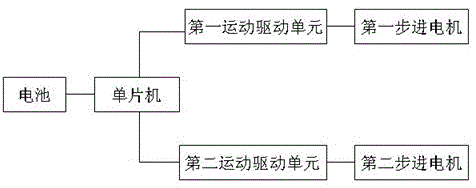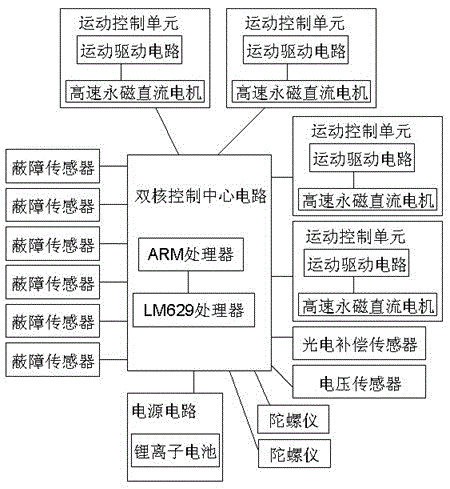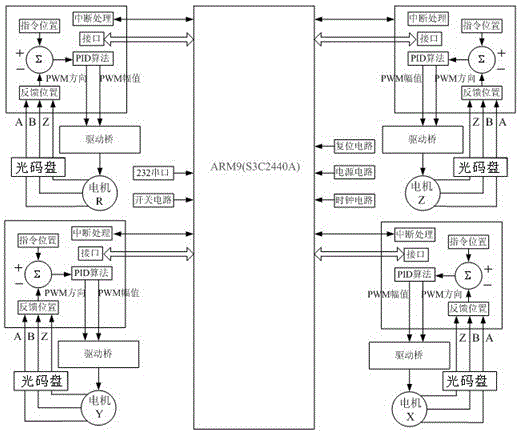[0009] (1) The eyes of the microcomputer mouse use ultrasonic or general
infrared sensors, and the sensor settings are wrong, so that the microcomputer mouse is blind to the surrounding area when it sprints quickly. There are some misjudgments in the judgment of the maze, which makes it easy for the microcomputer to hit the front wall when sprinting quickly
[0010] (2) As the
actuator of the microcomputer mouse, a
stepper motor is used, which often encounters the problem of missing pulses, resulting in errors in the memory of the sprint position. Sometimes I can't find the end of the sprint
[0011] (3) Due to the use of stepping motors, the body heats up seriously, which is not conducive to fast sprinting in large and complex mazes
[0012] (4) Due to the use of relatively low-level algorithms, there are certain problems in the calculation of the optimal maze and the calculation of the sprint path. The developed microcomputer mouse basically does not Multiple automatic acceleration sprints, sprints in the general maze generally take 15-30 seconds, which makes it impossible to win in the real international complex maze competition
[0013] (5) Since the microcomputer mouse needs to
brake and start frequently during the fast sprint process, which increases the
workload of the single-
chip microcomputer, the single-
chip signal processor cannot satisfy the
fast speed of the microcomputer mouse. sprint requirements
[0014] (6) Relatively, some relatively large plug-in components are used, which makes the size and weight of the microcomputer mouse relatively large, and the center of gravity is high, which cannot meet the fast sprint requirements
[0015] (7) Due to the interference of unstable factors in the surrounding environment, especially the interference of some surrounding light, the
microcontroller controller often appears abnormal, causing the microcomputer mouse to lose control, anti-interference Poor ability
[0016] (8) For a microcomputer mouse with differential speed control, it is generally required that the control signals of the two motors should be synchronized, but it is difficult for a single-
chip microcomputer , so that the microcomputer mouse will swing a lot in the maze when it sprints at high speed, and it often hits the wall, resulting in the failure of the sprint
[0017] (9) Due to the influence of the capacity and
algorithm of the single-chip microcomputer, the microcomputer mouse does not store the information of the maze, and all the information will disappear when it encounters a power failure, which makes The entire sprint cannot be completed
[0018] (10) Due to turning without the assistance of the
angular velocity sensor, the
turning angle is often too small or too large, and then it is compensated by the navigation sensor, resulting in In the maze with multiple turns in a row, the phenomenon of hitting the wall occurs, resulting in the failure of the sprint
[0019] (11) A single sensor is used to detect the barrier wall of the front maze, which is very easy to receive external interference, causing the front sensor to mislead the fast-sprinting microcomputer mouse, resulting in the microcomputer mouse The sprint in the maze is not in place or hits the wall, resulting in the sprint failure
[0020] (12) Due to the influence of the capacity of the single-chip microcomputer, the existing microcomputer mice basically only have two power driving wheels, and the two-wheel differential mode is used to drive, which makes the
system have higher requirements for the
servo of the two axes, especially for straight-line navigation. The speed and acceleration should be strictly consistent, otherwise the straight-line navigation will fail, causing the microcomputer mouse to hit the wall;
[0021] (13) The center of gravity of the two-wheeled microcomputer mouse system shifts backward during acceleration, making the front of the mouse light and floating. Even on a good road, the microcomputer mouse will slip, which may cause the phenomenon of hitting the wall, which is not conducive to the development of high-speed microcomputer mice.
[0022] (14) If the improper design of the two-wheel micro-
computer mouse system causes the center of gravity to shift forward during normal driving, the
positive pressure on the driving wheels will decrease. At this time, the micro-
computer mouse system is more likely to slip and deviate, resulting in navigation failure.
[0023] (15) If the two-wheel microcomputer mouse system is in normal driving, if the center of gravity is deflected due to improper design, the
positive pressure on the two driving wheels will be different, and the degree of slippage of the two wheels will be inconsistent during the
quick start, and the track will deviate instantly. When turning, among them Wheels with low
positive pressure may slip, making turning difficult
[0024] (16) Due to the use of two power wheels to drive, in order to meet the acceleration and deceleration in complex states, the power of a single
drive motor is relatively large, which not only occupies a large space, but also sometimes in some states with relatively low energy requirements The phenomenon of "big horses and small carts" appears, which is not conducive to the
miniaturization of the microcomputer mouse body and the energy saving of the microcomputer mouse system
 Login to View More
Login to View More  Login to View More
Login to View More 


